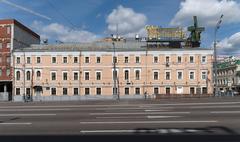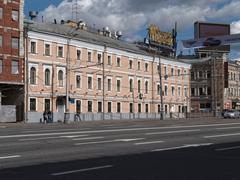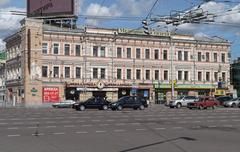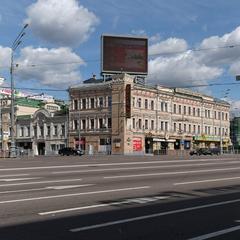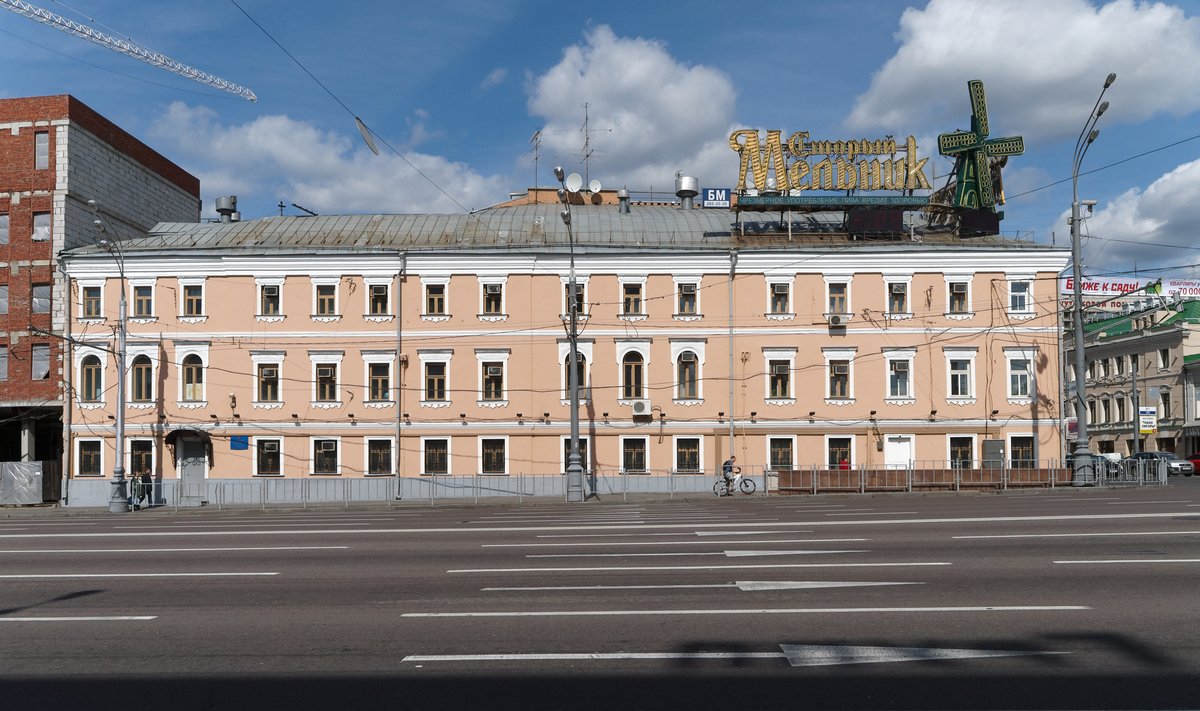
Mira Avenue Moscow Visiting Hours, Tickets, and Travel Guide
Date: 14/06/2025
Introduction to Mira Avenue Moscow
Mira Avenue (Prospekt Mira) stands as one of Moscow’s most prominent and historically significant thoroughfares. Stretching from the city center northwards for more than 15 kilometers, it encapsulates the city’s transformation from medieval times to the present day. Originally a trade route known as the Yaroslavskoye Highway, Mira Avenue evolved into a grand urban artery, now lined with architectural landmarks, cultural institutions, parks, and vibrant communities. Its blend of Stalinist grandeur, Soviet constructivism, and contemporary culture makes Mira Avenue a microcosm of Moscow’s layered history and a must-visit destination for travelers.
This guide provides comprehensive information on Mira Avenue’s historical development, key attractions, practical visiting advice—including hours, ticketing, and accessibility—and tips to optimize your experience. Whether you’re interested in Soviet-era monuments, lush green spaces, or Moscow’s urban lifestyle, this resource will equip you for a rewarding visit.
For more historical context and the latest updates, see Wikipedia: Prospekt Mira, the VDNKh official website, and curated travel guides like MissTourist.
Table of Contents
- Historical Overview
- Architectural Significance
- Visiting Mira Avenue: Practical Information
- Key Landmarks and Sites
- Parks and Green Spaces
- Dining, Shopping, and Entertainment
- Frequently Asked Questions (FAQ)
- Practical Tips for Visitors
- Conclusion
- Sources
Historical Overview
Origins and Early Development
Mira Avenue’s roots trace back to the ancient Yaroslavskoye Highway—a medieval trade route vital for connecting Moscow with the Russian North. As Moscow expanded in the 18th century, the avenue’s surroundings became increasingly urbanized, especially after the construction of the Kamer-Kollezhsky rampart in 1741, which marked the city’s boundary. By the 19th century, infrastructural innovations such as cobbled streets and the Mytischinskiy water pipeline spurred further development (Wikipedia: History of Moscow).
Soviet Era Expansion and Renaming
The 20th century brought dramatic change. With Moscow’s industrial and population boom, the avenue (then 1st Meshchanskaya) was widened and embellished with monumental buildings. In 1957, it was renamed Prospekt Mira (“Avenue of Peace”), reflecting Soviet ideals. The avenue became a showcase of socialist urbanism, lined with Stalinist and post-war architecture and serving as a ceremonial route to the All-Russian Exhibition Center (VDNKh) (Wikipedia: Prospekt Mira).
Architectural Significance
Mira Avenue offers a visual journey through Moscow’s architectural history:
- Stalinist and Soviet Modernism: Massive residential blocks and public buildings from the 1930s–1960s, including the iconic “House on Legs” (184 Mira Avenue), designed by Trifon Zaikin and Victor Andreev—a striking example of late Soviet constructivism (RBTH: Soviet Constructivist Buildings).
- Prospekt Mira Metro Station: A highlight of Stalinist architecture, featuring white marble arches, botanical motifs, and agricultural medallions (Michael Harrison: Prospekt Mira Metro).
- Historic Estates and Mansions: 18th- and 19th-century mansions, many of which now serve as museums and cultural centers, reflecting Moscow’s aristocratic past (News18: Moscow’s Tourism Renaissance).
Visiting Mira Avenue: Practical Information
How to Get There
- Metro: Key stations include Prospekt Mira (Koltsevaya and Kaluzhsko-Rizhskaya lines), VDNKh, and Alekseevskaya. Metro operates from ~6:00 AM to 1:00 AM, with frequent trains (Russiable).
- Surface Transport: Numerous buses, trams, and trolleybuses serve the avenue. The Troika Card allows seamless transfers across modes (ProTransport).
- Taxis: Use official apps (Yandex Taxi, Uber, Gett) for safety (Travelsafe-Abroad).
Visiting Hours and Tickets
- VDNKh: Park is open daily 9:00–22:00; pavilions and exhibitions typically 10:00–20:00. Entry to grounds is free; exhibitions 300–500 RUB (VDNKh official site).
- Museum of Cosmonautics: Open Tues–Sun 10:00–18:00; closed Mon and last Fri monthly. Tickets ~250–350 RUB (Memorial Museum of Cosmonautics).
- Ostankino TV Tower: Open 11:00–20:00, tickets ~1000 RUB. Book online in advance (Discover Moscow).
- Moscow Botanical Garden: Open 10:00–19:00 daily. Tickets ~250 RUB (Main Botanical Garden).
- Metro Stations: Open during general metro hours; entry with standard ticket.
Accessibility and Guided Tours
- Accessibility: Major landmarks (VDNKh, Museum of Cosmonautics, Botanical Garden) offer wheelchair access and accessible facilities. Some metro stations are partially accessible (WeHeart.Moscow).
- Guided Tours: Walking tours covering architecture, Soviet history, or themed experiences (e.g., space exploration) are widely available and can be booked via agencies or online.
Special Events and Photography Spots
- Events: Annual festivals at VDNKh, science fairs at the Museum of Cosmonautics, and flower shows at the Botanical Garden enliven the avenue year-round.
- Top Photo Spots: The Worker and Kolkhoz Woman monument, Monument to the Conquerors of Space, VDNKh fountains, and panoramic views from Ostankino Tower.
Key Landmarks and Sites
VDNKh (All-Russian Exhibition Center)
A vast complex with 400+ pavilions, thematic gardens, and landmark sculptures such as the Friendship of Peoples Fountain and Space Pavilion. Access to the grounds is free; museum/exhibit tickets vary (Wikipedia: VDNKh).
Monument to the Conquerors of Space & Museum of Cosmonautics
The 107-meter titanium spire and the museum below celebrate Soviet and Russian space achievements, with interactive exhibits and artifacts from the space age (Memorial Museum of Cosmonautics).
Worker and Kolkhoz Woman
A 24.5-meter stainless steel statue by Vera Mukhina, symbolizing Soviet industrial optimism. Located near VDNKh, it is freely accessible outdoors (Worker and Kolkhoz Woman).
Ostankino TV Tower
Europe’s tallest free-standing structure, offering observation deck views and interactive exhibits (Discover Moscow).
Prospekt Mira Metro Station
Renowned for its marble, ceramic, and botanical motifs, this is both a functional transit hub and an architectural gem (Michael Harrison: Prospekt Mira Metro).
Parks and Green Spaces
- Moscow Botanical Garden: Over 360 hectares with 18,000+ plant species and themed gardens (Main Botanical Garden).
- Sokolniki Park: Historic park ideal for recreation, accessed from Mira Avenue.
- Ostankino Park and Palace: Scenic trails, ponds, and the 18th-century Ostankino Palace.
- Ekaterininsky Park: A tranquil, tree-filled retreat south along the avenue.
Dining, Shopping, and Entertainment
Mira Avenue features diverse cafés, bakeries, and restaurants ranging from traditional Russian cuisine to international fare. Shopping options include markets and malls, while entertainment venues like the historic Cosmos Cinema offer cultural experiences (MissTourist).
Frequently Asked Questions (FAQ)
Q: What are typical visiting hours for Mira Avenue’s main attractions?
A: Most attractions are open 10:00–19:00; VDNKh park grounds are open until 22:00. Check official sites for seasonal variations.
Q: Where can I buy tickets?
A: Purchase at venue ticket offices or online via official websites. Advance booking is recommended for popular sites.
Q: Are guided tours available?
A: Yes, a range of tours cover history, architecture, and themed interests.
Q: Is the avenue accessible for people with disabilities?
A: Most main attractions offer accessible facilities; some metro stations may have limited access.
Q: What public transport serves Mira Avenue?
A: Metro (Prospekt Mira, VDNKh, Alekseevskaya), buses, trams, and trolleybuses, all payable with the Troika Card.
Q: Are major sites wheelchair accessible?
A: VDNKh, the Museum of Cosmonautics, and Botanical Garden provide wheelchair access; check individual sites for details.
Practical Tips for Visitors
- Best Time to Visit: Late spring to early autumn for outdoor enjoyment; winter offers festive lights and activities.
- Transport Tips: Use the Metro and Troika Card for efficiency; avoid rush hour crowds when possible.
- Safety: Central Moscow is safe; be mindful of pickpockets in busy areas and use only official taxi apps (TravellersWorldwide).
- Language: English signage is present at main sites, but basic Russian phrases or a translation app can be helpful.
- Dining: Tipping 10% is customary in sit-down venues; a wide variety of cuisines is available.
- Connectivity: Free Wi-Fi at Metro stations and VDNKh; SIM cards available with a passport.
- Emergencies: Dial 112 for police/fire/medical help; keep passport and visa copies on hand.
Conclusion
Mira Avenue is more than a transportation corridor—it’s a living exhibition of Moscow’s history, architecture, and culture. From monumental Soviet landmarks and lush parks to innovative museums and bustling urban life, the avenue offers something for every visitor. By checking up-to-date visiting hours, planning ticket purchases, and utilizing public transport, you can maximize your experience along this iconic Moscow street.
Download the Audiala app for the latest information, audio guides, and exclusive tour recommendations. Follow us on social media for updates, events, and insider tips as you embark on your journey through the heart of Moscow.
Sources
- Wikipedia: History of Moscow
- Wikipedia: Prospekt Mira (Moscow)
- Wikipedia: VDNKh (Moscow)
- RBTH: 10 Soviet Constructivist Buildings
- Michael Harrison: Prospekt Mira Metro
- News18: Moscow’s Tourism Renaissance
- Britannica: Moscow Cultural Life
- NewGeography: Evolving Urban Form
- PlanetWare: Top-Rated Tourist Attractions
- Rehlat: Things to Do in Moscow
- Discover Moscow
- ArchDaily: Moscow Urban Movement
- Russiable: Troika Card Public Transport
- ProTransport: Moscow Transport Information
- MissTourist: 18 Best Things to Do in Moscow
- TravellersWorldwide: Is Moscow Safe?
- WeHeart.Moscow: Public Transport Accessibility
- Travelsafe-Abroad: Russia Travel Safety
- Main Botanical Garden
- Memorial Museum of Cosmonautics
- Worker and Kolkhoz Woman
- VDNKh Official Site
